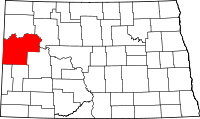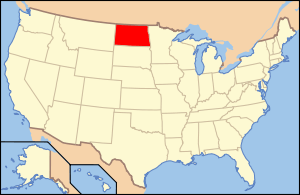McKenzie County, North Dakota
| McKenzie County, North Dakota | |
|---|---|
 Location in the U.S. state of North Dakota | |
 North Dakota's location in the U.S. | |
| Founded | April 20, 1905 |
| Named for | Alexander McKenzie |
| Seat | Watford City |
| Largest city | Watford City |
| Area | |
| • Total | 2,861 sq mi (7,410 km2) |
| • Land | 2,760 sq mi (7,148 km2) |
| • Water | 100 sq mi (259 km2), 3.5% |
| Population (est.) | |
| • (2015) | 12,826 |
| • Density | 2.3/sq mi (1/km²) |
| Congressional district | At-large |
| Time zones |
Central: UTC-6/-5 (northern portion) |
|
Mountain: UTC-7/-6 (southern portion) | |
| Website |
county |
McKenzie County is a county located in the U.S. state of North Dakota. As of the 2010 census, the population was 6,360.[1] Its county seat is Watford City.[2] Between 2010 and 2015, according to Census Bureau estimates, it was the fastest growing county in the United States, growing 101.7 percent.[3] The county lies immediately adjacent to the Williston Micropolitan Statistical Area, although, technically, by Census Bureau definition, is not a part of it.
McKenzie County was first created by the March 8, 1883 Dakota Territory legislature but eliminated in 1891 due to a lack of settlement. The county was then recreated by the 1905 state legislature, with the county government first organizing on April 20, 1905.[4][5] The name comes from early North Dakota politician Alexander McKenzie.[6] Before becoming Watford City, the county seat was Alexander from 1905 to 1907 and Schafer from 1907 to 1941.[4]
Geography
According to the U.S. Census Bureau, the county has a total area of 2,861 square miles (7,410 km2), of which 2,760 square miles (7,100 km2) is land and 100 square miles (260 km2) (3.5%) is water.[7] It is the largest county in North Dakota by area.
The McKenzie County landscape features a wide diversity of physical features, ranging from sugarbeet fields bordering the Missouri River at the northwest corner of the county to rugged badlands near the Little Missouri River in the south, where Theodore Roosevelt National Park and the Little Missouri National Grassland are located. Between the two rivers is a large area of prairie, ranging from gentle rolling terrain to rocky, rugged pastures. The southeast corner of the county, bordering on the Little Missouri badlands of neighboring Dunn County, is abundant in wildlife, quaking aspen groves, and bur oak groves, interspersed in places with western red cedar on the north-facing slopes of the badlands.
Adjacent counties
- Williams County (north)
- Mountrail County (northeast)
- Dunn County (southeast)
- Billings County (south)
- Golden Valley County (southwest)
- Wibaux County, Montana (southwest)
- Richland County, Montana (west)
Major highways
 U.S. Highway 85
U.S. Highway 85 North Dakota Highway 22
North Dakota Highway 22 North Dakota Highway 23
North Dakota Highway 23 North Dakota Highway 58
North Dakota Highway 58 North Dakota Highway 68
North Dakota Highway 68 North Dakota Highway 73
North Dakota Highway 73 North Dakota Highway 200
North Dakota Highway 200 North Dakota Highway 1806
North Dakota Highway 1806
National protected areas
Demographics
| Historical population | |||
|---|---|---|---|
| Census | Pop. | %± | |
| 1910 | 5,720 | — | |
| 1920 | 9,544 | 66.9% | |
| 1930 | 9,709 | 1.7% | |
| 1940 | 8,426 | −13.2% | |
| 1950 | 6,849 | −18.7% | |
| 1960 | 7,296 | 6.5% | |
| 1970 | 6,127 | −16.0% | |
| 1980 | 7,132 | 16.4% | |
| 1990 | 6,383 | −10.5% | |
| 2000 | 5,737 | −10.1% | |
| 2010 | 6,360 | 10.9% | |
| Est. 2015 | 12,826 | [8] | 101.7% |
| U.S. Decennial Census[9] 1790-1960[10] 1900-1990[11] 1990-2000[12] 2010-2015[1] | |||
2000 census
As of the census of 2000, there were 5,737 people, 2,151 households, and 1,548 families residing in the county. The population density was 2 people per square mile (1/km²). There were 2,719 housing units at an average density of 1 per square mile (0/km²). The racial makeup of the county was 77.36% White, 0.07% Black or African American, 21.18% Native American, 0.05% Asian, 0.02% Pacific Islander, 0.14% from other races, and 1.19% from two or more races. 1.01% of the population were Hispanic or Latino of any race. 33.4% were of Norwegian and 20.9% German ancestry.
There were 2,151 households out of which 34.50% had children under the age of 18 living with them, 57.90% were married couples living together, 9.30% had a female householder with no husband present, and 28.00% were non-families. 25.80% of all households were made up of individuals and 13.10% had someone living alone who was 65 years of age or older. The average household size was 2.64 and the average family size was 3.17.
In the county the population was spread out with 30.60% under the age of 18, 5.50% from 18 to 24, 23.30% from 25 to 44, 24.90% from 45 to 64, and 15.70% who were 65 years of age or older. The median age was 40 years. For every 100 females there were 100.70 males. For every 100 females age 18 and over, there were 98.90 males.
The median income for a household in the county was $29,342, and the median income for a family was $34,091. Males had a median income of $26,351 versus $20,147 for females. The per capita income for the county was $14,732. About 13.70% of families and 17.20% of the population were below the poverty line, including 22.10% of those under age 18 and 12.70% of those age 65 or over.
2010 census
As of the 2010 United States Census, there were 6,360 people, 2,410 households, and 1,682 families residing in the county.[13] The population density was 2.3 inhabitants per square mile (0.89/km2). There were 3,090 housing units at an average density of 1.1 per square mile (0.42/km2).[14] The racial makeup of the county was 75.3% white, 22.2% American Indian, 0.3% Asian, 0.1% black or African American, 0.4% from other races, and 1.6% from two or more races. Those of Hispanic or Latino origin made up 2.2% of the population.[13] In terms of ancestry, 39.5% were Norwegian, 30.6% were German, 6.1% were Irish, and 0.7% were American.[15]
Of the 2,410 households, 33.7% had children under the age of 18 living with them, 52.7% were married couples living together, 10.2% had a female householder with no husband present, 30.2% were non-families, and 25.3% of all households were made up of individuals. The average household size was 2.58 and the average family size was 3.06. The median age was 38.0 years.[13]
The median income for a household in the county was $48,480 and the median income for a family was $58,906. Males had a median income of $42,803 versus $33,056 for females. The per capita income for the county was $27,605. About 6.7% of families and 10.0% of the population were below the poverty line, including 12.8% of those under age 18 and 10.0% of those age 65 or over.[16]
Communities
Cities
- Alexander
- Arnegard
- Watford City (county seat)
Townships
- Alex
- Antelope Creek
- Arnegard
- Blue Butte
- Charbon
- Elm Tree
- Ellsworth
- Grail
- Hawkeye
- Keene
- Randolph
- Riverview
- Sioux
- Tri
- Twin Valley
- Yellowstone
Defunct Townships
Elk, Poe, and Wilbur townships merged January 1, 2002 to form Tri Township.[17]
Census-designated places
Unincorporated communities
Sites of interest
See also
Coordinates: 47°44′N 103°23′W / 47.73°N 103.39°W
References
- 1 2 "State & County QuickFacts". United States Census Bureau. Retrieved November 1, 2013.
- ↑ "Find a County". National Association of Counties. Archived from the original on May 31, 2011. Retrieved 2011-06-07.
- ↑ http://www.census.gov/popest/data/counties/totals/2015/CO-EST2015-alldata.html
- 1 2 "County History". Official Portal for North Dakota State Government. Retrieved 4 May 2011.
- ↑ "Dakota Territory, South Dakota, and North Dakota: Individual County Chronologies". Dakota Territory Atlas of Historical County Boundaries. The Newberry Library. 2006. Retrieved February 1, 2015.
- ↑ Gannett, Henry (1905). The Origin of Certain Place Names in the United States. U.S. Government Printing Office. p. 194.
- ↑ "2010 Census Gazetteer Files". United States Census Bureau. August 22, 2012. Retrieved February 1, 2015.
- ↑ "County Totals Dataset: Population, Population Change and Estimated Components of Population Change: April 1, 2010 to July 1, 2015". Retrieved July 2, 2016.
- ↑ "U.S. Decennial Census". United States Census Bureau. Archived from the original on May 11, 2015. Retrieved February 1, 2015.
- ↑ "Historical Census Browser". University of Virginia Library. Retrieved February 1, 2015.
- ↑ Forstall, Richard L., ed. (April 20, 1995). "Population of Counties by Decennial Census: 1900 to 1990". United States Census Bureau. Retrieved February 1, 2015.
- ↑ "Census 2000 PHC-T-4. Ranking Tables for Counties: 1990 and 2000" (PDF). United States Census Bureau. April 2, 2001. Retrieved February 1, 2015.
- 1 2 3 "DP-1 Profile of General Population and Housing Characteristics: 2010 Demographic Profile Data". United States Census Bureau. Retrieved 2016-03-14.
- ↑ "Population, Housing Units, Area, and Density: 2010 - County". United States Census Bureau. Retrieved 2016-03-14.
- ↑ "DP02 SELECTED SOCIAL CHARACTERISTICS IN THE UNITED STATES – 2006-2010 American Community Survey 5-Year Estimates". United States Census Bureau. Retrieved 2016-03-14.
- ↑ "DP03 SELECTED ECONOMIC CHARACTERISTICS – 2006-2010 American Community Survey 5-Year Estimates". United States Census Bureau. Retrieved 2016-03-14.
- ↑ Historical census data
External links
 |
Williams County | Mountrail County |  | |
| Richland County, Montana | |
|||
| ||||
| | ||||
| Wibaux County, Montana and Golden Valley County | Billings County | Dunn County |